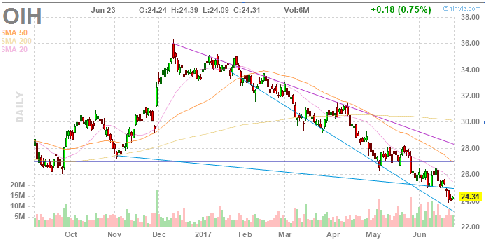Oil producers have scaled back locking in future prices “considerably” since February, Societe Generale SA said in a report, citing a shift in options pricing driven by consumer companies like shippers and airlines. Late last year, sellers including U.S. shale drillers locked in prices in droves when benchmarks rose after OPEC announced plans to cut production.
“This is a significant shift in the relative producer-consumer hedging behavior,” wrote David Schenck, a cross-commodity strategist at Societe Generale. “While consumers may try to lock in low prices, most producers will simply refuse to lock-in loss-making prices.”
Brent’s 12-month put skew closed at its lowest level since May 2016 on Monday. This indicator tends to rise when producers of oil are locking in their supply and fall when consumers, including shippers and airlines, hedge their output. The second-month equivalent was at its lowest level since December 2015. WTI skews have also fallen sharply since OPEC’s last meeting on May 25. Crude in New York touched $42.75 a barrel on Tuesday, the lowest level since Nov. 14, and was closing in on a bear market. Read more

On the other hand, we recall that Mexico just started its famous oil hedging program by buying put options
Mexico has taken the first step in its annual oil hedging program, asking Wall Street banks for price quotes on the put options it buys to lock in prices for the following year, according to people familiar with the matter.
The put options give Mexico the right, but not the obligation, to sell oil at a predetermined price and time. The hedge runs from December to November. Read more
So who’s right?
We note that the Mexican hedgers have had a good track record
The Latin American country has received handsome payouts from its oil hedging program, earning a record $6.4 billion in 2015 after OPEC embarked on a war for market share that sent prices tumbling. Mexico made $5 billion in 2009, after the global financial crisis, and another $2.7 billion in 2016.
Since the modern oil hedge program started in 2001, Mexico has made a profit of $2.4 billion — its hedges raked in $14.1 billion in gains and paid out $11.7 billion in fees to banks and brokers. The country also made money in the 1990s, when the hedge wasn’t done on an annual basis.
ByMarketNews

No comments:
Post a Comment